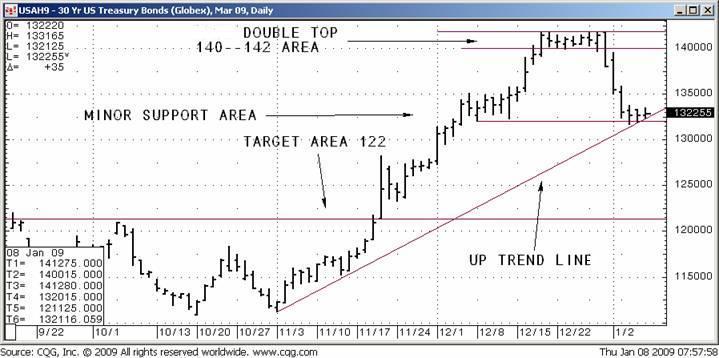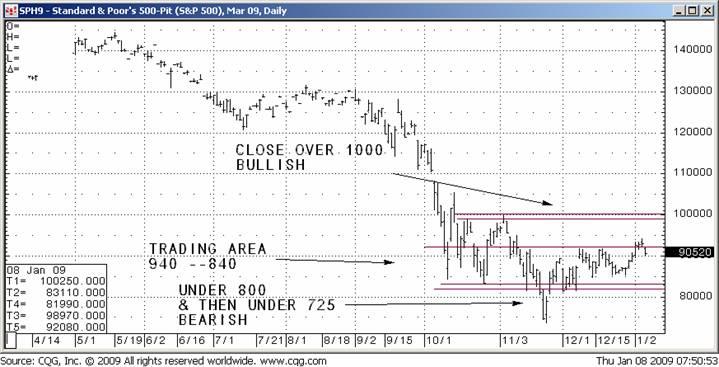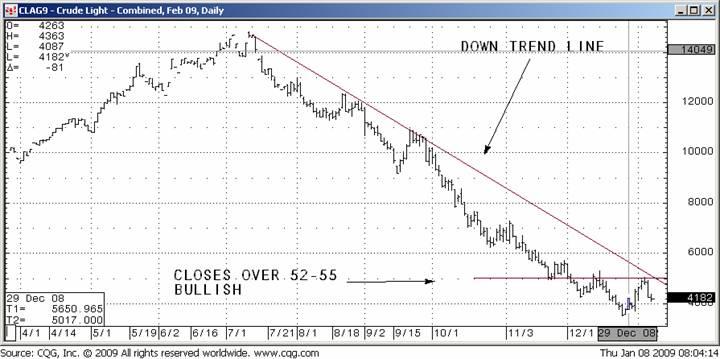Wow, what a year we had. We had the best of times and the worst of times in commodities all in one year. Obviously, 2008 was a very volatile year, and it’s hard to know what to expect for 2009. I do think risk-aversion will start to fade, and I think it’s time to take a nibble at the long side in stock indexes and commodities that have been forming bottoms.
The economy still looks bad, no question about it. The December employment report (due out on Friday, January 9, 2009) is not likely to bring good news, and will set the tone for the market in the short-term. Forecasters are expecting the unemployment rate to rise to 7 percent, while non-farm payrolls are seen dropping 500,000.
Consumers have been paranoid, afraid, and not spending. It was the worst season for retailers in decades. Retailers have been slashing their profit outlooks, closing stores, and some are facing bankruptcy. That might be healthy in the long-term, but will have a negative impact in the short-term for the stock market. We’ve even seen discount retailers like Wal-Mart miss their projections. As a result, the commercial real estate market is a wildcard that could create problems for the market, and ignite renewed panic. So keep an eye on that.
Stock and Bond Markets
In early December, I felt panic was still in play, and risk-aversion was in force. Investors were flooding into Treasuries as a safe-haven. The Chicago Board Options Exchange Market Volatility Index (VIX) topped out just above 80 on November 20, 2008, the highest in 19 years. In simple terms, the VIX represents a measure of how much “insurance” investors are willing to pay against stock market declines, using options. It’s widely quoted as a measure of “investor fear.” Since late December, we’ve seen a subsiding of some panic. The index has fallen four straight weeks and has dropped below 40. It’s a sign investors are a little more confident about the market’s prospects. We didn’t really get a Santa Claus rally in stocks before Christmas, but we did get one after. Although the market is still volatile, declines in January have been more orderly, and less panicky.

In Treasuries, we saw a double-top formation near 141 in December that was followed by a huge move lower. I view 122 as a likely near-term target, and I’d be a seller in Treasury bond futures on rallies this month. I recommend buying puts if you’d like more defined risk parameters. Be cautious if Treasury bond futures move above 142, as that would mean investors remain fearful. In that case, it would likely be accompanied by a stock market decline that could see a retest of the 2008 lows.
Stocks might test the 2008 lows, but I don’t see the market moving lower than that in early 2009. We could see 725 in front-month S&P futures, but not likely 700. I’m a bit more optimistic looking at technical charts.
The S&P futures have been in a trading range over the past two-three weeks from about 840 – 940. I would play that range in January; sell as the March contract approaches 940, and buy approaching 840. A close above 940 would likely bring 1,000 in view. This market has broken some trendlines and is holding above the 10-day moving average near 897. That’s encouraging to me that the bulls are still in command. A close under 840 would make me more bearish, however.

We have a new president coming in, and it looks like we are going to have new stimulus packages, and tax cuts. The markets should rally on hope things will improve. It won’t be a rally on substance yet, but on hope. Substance will come later. The housing market likely won’t bottom for six months to a year, but a return of confidence needs to come first.
Commodities
I project that we will see the return of inflation in 2009. Let’s take a look at crude oil, which I believe is a market most traders need to keep an eye on as it impacts so many other markets. It represents what we saw in commodities in general in 2008–the bull market in the first half of the year, then bear market in the second. Crude oil topped out above $147 a barrel in July 2008, then two years of gains were taken out in just five months. The lows were in around Christmas, and a shift higher came in the final days of the year. Investors started to gain confidence, and crude oil rallied in tandem with stocks. After sliding below $35 a barrel in mid-December 2008, crude oil had rallied to above $50 by Tuesday, January 6, 2009.
Crude oil corrected back after topping $50, falling 12 percent on Wednesday, January 7, on news inventories were greater than expected. The latest weekly inventory report from the Energy Information Administration showed crude oil stockpiles reached 325.4 million barrels in the week ended Jan. 2, up 6.7 million barrels from a week ago. Analysts were not expecting this large a surplus and it incited a big price drop. Demand is not as strong as we thought. If crude oil moves below $41, then I do see $35 back in view.

However, from a technical viewpoint, the market has remained above the 10-day moving average, which is bullish. I think this mid-week pullback is a good opportunity to consider buying for a bigger move in coming months. I think it’s more likely than not 2008 lows will hold.
I believe it may take three or four months for the bull market in commodities to resume. I certainly don’t want to bet the farm on getting long crude oil, but I would try to nibble at it. A close above $52 would put my next upside target at $65.
I also like corn, which has been trading with a similar trend as crude oil. Corn looks good near $3 a bushel, where it bottomed, and that’s where I recommend buying. I’d also recommend buying copper this winter if the housing market shows signs of life. Copper is an industrial metal used heavily in construction, and a good gauge of the economy in general.
Sometime in 2009, I think the commodity markets will come back to life. The government has a lot of debt to finance, and that is likely to be inflationary. There has been talk of buying 30-year Treasuries as policymakers have been trying to force yields down to lower mortgage rates, and unfreeze the credit market in general. At some point, I think we will see huge spikes in commodities and the stock market, and the dollar will weaken. Investors will move out of Treasury safe-havens, seeking higher returns. We will have deflation, however, as long as the fear factor remains. Watch consumer spending, watch the job market, and watch currency moves.
I’m not looking for home runs in January; there is still a lot of uncertainty and the markets are likely to remain volatile. I wouldn’t recommend risking a large amount in these markets. Just get on base with a single. We need some consolidation and bottoming action. At the same time, I would not load up on the short side in stocks or commodities as I don’t see more panic selling likely. I’d recommend investors use the declines of last year to seek bargains for better price action in coming months.
To summarize January, I think it will be a month of continued negative news on the economy, but also a month of hope. For the markets, it will likely be a bottoming month. We’re licking our wounds, and slowly will start to heal.
Please feel free to call me to discuss these or other markets, and to incorporate specific trading strategies for your account size and risk tolerance. Good luck and good trading!
Jeff Friedman is a Senior Market Strategist with Lind Plus. He can be reached at 866-231-7811 or via email at jfriedman@lind-waldock.com. Join Jeff for his monthly webinar, Friedman’s Futures Forecast, by visiting Lind-Waldock’s events page. You can view an archived webinar of this forecast at www.lind-waldock.com/events, where Jeff covers even more detail.
Past performance is not necessarily indicative of future trading results. Trading advice is based on information taken from trade and statistical services and other sources which Lind-Waldock believes are reliable. We do not guarantee that such information is accurate or complete and it should not be relied upon as such. Trading advice reflects our good faith judgment at a specific time and is subject to change without notice. There is no guarantee that the advice we give will result in profitable trades. All trading decisions will be made by the account holder.
Futures trading involves substantial risk of loss and is not suitable for all investors. 2009 MF Global Ltd. All Rights Reserved. Futures Brokers, Commodity Brokers and Online Futures Trading. 141 West Jackson Boulevard, Suite 1400-A, Chicago, IL 60604.



